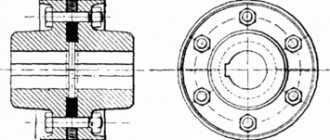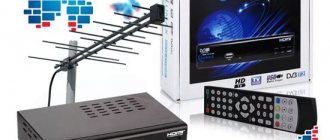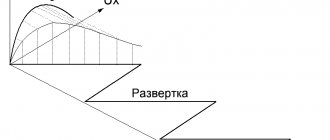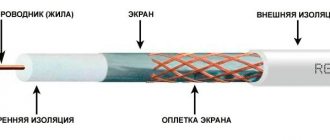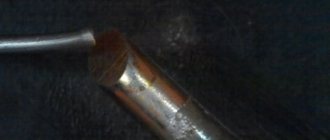Types of signals
A signal is a change in a physical quantity in time and space. Essentially, these are codes for data exchange in information and management environments. Graphically, any signal can be represented as a function. From the line on the graph you can determine the type and characteristics of the signal. Analog will look like a continuous curve, digital will look like a broken rectangular line jumping from zero to one. Everything we see with our eyes and hear with our ears comes in the form of an analog signal.
Analog signal
Vision, hearing, taste, smell and tactile sensations come to us in the form of an analog signal. The brain commands the organs and receives information from them in analog form. In nature, all information is transmitted only this way.
In electronics, an analog signal is based on the transmission of electricity. Certain voltage values correspond to the frequency and amplitude of sound, the color and brightness of image light, and so on. That is, color, sound or information are analogous to electrical voltage.
For example : Let's set the transmission of colors with a certain voltage: blue 2 V, red 3 V, green 4 V. By changing the voltage we get a picture of the corresponding color on the screen.
It doesn’t matter whether the signal comes through wires or radio. The transmitter continuously sends and the receiver processes analogue information. Receiving a continuous electrical signal through wires or a radio signal over the air, the receiver converts the voltage into the corresponding sound or color. The image appears on the screen or the sound is broadcast through the speaker.
Discrete signal
The whole point is in the name. Discrete from the Latin discretus, meaning discontinuous (divided). We can say that the discrete one repeats the amplitude of the analogue one, but the smooth curve turns into a stepped one. Changing either in time, remaining continuous in magnitude, or in level, without interruption in time.
So, in a certain period of time (for example, a millisecond or a second), a discrete signal will be of some set value. At the end of this time, it will change sharply up or down and remain that way for another millisecond or second. And so on continuously. Therefore, discrete is converted analog. That is, halfway to digital.
Digital signal
After discrete, the next step in analog conversion was the digital signal. The main feature is that either it is there or it is not. All information is converted into signals limited in time and magnitude. Signals of digital data transmission technology are encoded with zero and one in different versions. And the basis is a bit that takes one of these values. Bit from English binarydigit or binary digit.
But one bit has a limited ability to transmit information, so they were combined into blocks. The more bits in one block, the more information it carries. Digital technologies use bits combined into blocks divisible by 8. An eight-bit block is called a byte. One byte is a small amount, but it can already store encrypted information about all the letters of the alphabet. However, by adding just one bit, the number of combinations of zero and one doubles. And if 8 bits makes 256 encoding options possible, then 16 is already 65536. And a kilobyte or 1024 bytes is not a small amount.
ATTENTION! There is no error that 1 KB is equal to 1024 bytes. This is common practice in a binary computing environment. But the decimal system is widely used in the world, where kilo is 1000. Therefore, there is also a decimal KB equal to 1000 bytes.
A large number of concatenated bytes store a lot of information; the more combinations of 1s and 0s, the more is encoded. Therefore, in 5 – 10 MB (5000 – 10000 kB) we have good quality music track data. Let's go further, and the film is already encoded in 1000 MB.
Lectures on ITZ / 09. Characteristics of analog and discrete signals
09.Characteristics of analog and discrete signals.
To analog signals
These are signals whose level (amplitude) can take arbitrary values within a certain interval for the signal.
The amplitude of a simple and fairly common harmonic signal in nature varies according to a sinusoidal law:
Most analog signals have a more complex shape. Periodic (repeating through time T - period) signals of arbitrary shape can be represented in accordance with the Fourier formula in the form of a sum of harmonic oscillations:
The parameters of the Fourier series are calculated using the corresponding formulas. The Fourier series is a mathematical model of a periodic signal. The totality of the harmonic components of a signal form its spectrum.
The amplitude of each spectral component characterizes the energy of the corresponding harmonic of the fundamental frequency of the signal. The higher the rate of change in the signal amplitude, the more high-frequency harmonics there are in its spectrum. The difference between the maximum and minimum frequencies of the signal spectrum, between which the main part, for example, 95% of the energy is concentrated, is called the spectrum width
. A graphical representation of the spectrum of a periodic signal is presented in Fig. 1.5.
The frequencies of the spectrum components of a non-periodic analog signal are continuously changing. When observing the spectrum of such a signal on the screen of a spectrum analyzer, the position and level of various spectral components continuously change and the spectrum appears as continuous.
In accordance with the change in the amplitude of the analog signal, its energy or power changes (since power is proportional to the square of the amplitude). Depending on the time of measurement of signal energy, a distinction is made between average and instantaneous power. The decimal logarithm of the ratio of the maximum to the minimum signal power is called the dynamic range of the signal.
Thus, an analog signal is described by a set of parameters that are its characteristics. These include:
- frequency or range of frequencies;
- signal phase;
- signal duration;
- signal amplitude or power;
- signal spectrum width;
- dynamic range of the signal.
For discrete signals
amplitude has a finite, predetermined set of values. The most widely used binary signal is a discrete signal. Information signals circulating in the IBM PC computer have two amplitude levels: low and high. The oscillogram of the binary signal is shown in Fig. 1.6.
The spectrum of a discrete periodic signal contains an infinite number of harmonics decreasing in amplitude. For a binary periodic signal, a fragment of the spectrum is shown in Fig. 1.7.
When discrete signals pass through real electrical circuits of radio equipment with a limited bandwidth, their shape is distorted and the steepness of the pulse slope decreases. The rectangular pulse takes on a bell shape. As a result, the boundary between the form of analog and discrete signals is blurred. Distortion of the shape and reduction in the amplitude of pulse signals in cable wires limit their transmission range, for example, to ensure machine-to-machine data exchange in local networks.
By their physical nature, signals can be acoustic, electrical, magnetic, electromagnetic (in the radio range - radio signals), corpuscular (in the form of streams of elementary particles) and material, for example, odorous additives in gas give a signal about its leakage.
Signals, according to the type of information transmitted, are divided into speech, telegraph, telecode, facsimile, television, radioactive radiation and conditional. Telegraph and telecode signals are used to transmit alphanumeric information at low and high speeds, respectively. Fax and television signals provide the transmission of still and moving images. Signals of radioactive radiation are unmasking signs of radioactive substances. Conditioned signals carry information, the content of which is predetermined between its source and recipient.
The type of information contained in the signal changes its unmasking features: shape, spectrum width, frequency and dynamic range. For example, a standard speech signal transmitted over a telephone line has a spectrum width of 300-3400 Hz, audio - 16-20000 Hz, television - 6-8 MHz, etc.
In terms of time of occurrence, signals can be regular, the time of occurrence of which is known to the recipient of the information, for example, signals of exact time, and random, when this time is unknown. Statistical characteristics of the manifestation of random signals over time can represent quite informative unmasking signs of sources, first of all, about their affiliation and modes of operation. For example, the appearance of a radio signal in a room during conversations in it can, with a fairly high probability, serve as a unmasking sign of a mortgaged device with an acoustic machine.
The difference between a discrete signal and a digital one
Everyone has probably heard about Morse code. It was invented by the artist Samuel Morse, other innovators improved it, and used everything. This is a method of transmitting text where letters are encoded with dots and dashes. Simplified, the encoding is called Morse code. It was used for a long time in the telegraph and for transmitting information via radio. In addition, you can signal using a spotlight or flashlight.
The Morse code depends only on the sign itself. And not on its duration or volume (strength). No matter how you hit the key (blink a flashlight), only two options are perceived - a dot and a dash. You can only increase the transfer speed. Neither volume nor duration are taken into account. The main thing is that the signal gets through.
So is the digital signal. It is important to encode the data using 0s and 1s. The recipient only has to parse the combination of zeros and ones. It doesn’t matter how loud or how long each signal will be. It is important to get the ones and zeroes. This is the essence of digital technology.
A discrete signal will be obtained if you also encode the volume (brightness) and duration of each dot and dash, or 0 and 1. In this case, there are more encoding options, but there is also confusion. The volume and duration can be inaudible. This is the difference between digital and discrete signals. Digital is generated and perceived unambiguously, discretely with variations.
Discrete signal
Nowadays, every person uses a mobile phone or some kind of “dialer” on their computer. One of the tasks of devices or software is to transmit a signal, in this case a voice stream. To carry a continuous wave, a channel is required that has the highest level of throughput. That is why the decision was made to use a discrete signal. It does not create the wave itself, but its digital appearance. Why? Because the transmission comes from technology (for example, a telephone or computer). What are the advantages of this type of information transfer? With its help, the total amount of transmitted data is reduced, and batch sending is also easier to organize.
The concept of “sampling” has long been steadily used in the work of computer technology. Thanks to this signal, not continuous information is transmitted, which is completely encoded with special symbols and letters, but data collected in special blocks. They are separate and complete particles. This encoding method has long been relegated to the background, but has not disappeared completely. It can be used to easily transmit small pieces of information.
Comparison of digital and analog signals
The signal from a telecentre radio station or mobile phone can be transmitted in digital and analogue form. For example, sound and image are analog signals. The microphone and camera perceive the surrounding reality and convert it into electromagnetic waves. The output oscillation frequency depends on the frequency of sound and light, and the transmission amplitude depends on volume and brightness.
Image and sound converted into electromagnetic waves are distributed into space by a transmitting antenna. The reverse process occurs in the receiver - electromagnetic oscillations into sound and video.
The propagation of electromagnetic oscillations in the air is hindered by clouds, thunderstorms, terrain, industrial electrical noise, solar wind and other interference. Frequency and amplitude are often distorted and the signal from the transmitter to the receiver comes with changes.
The voice and picture of the analog signal are reproduced with distortion caused by interference, and hissing, crackling and color distortion are reproduced in the background. The worse the reception, the more pronounced these side effects are. But if the signal has arrived, it is at least somehow visible and audible.
With digital transmission, the image and sound are digitized before broadcasting and reach the receiver without distortion. The influence of extraneous factors is minimal. Sound and color are of good quality or none at all. The signal is guaranteed to reach a certain distance. But long-distance transmission requires a number of repeaters. Therefore, to transmit a cellular signal, antennas are placed as close to each other as possible.
Features of analogue and digital television
The philistine judgment about the collapse of terrestrial TV and the transition to broadcasting technologies of the future is somewhat unfair, if only because TV viewers are replacing the concepts: terrestrial and analog TV. After all, terrestrial television is usually understood as any television broadcast over a terrestrial radio channel.
Both “analog” and “digital” are types of terrestrial TV. Despite the fact that analogue television differs from digital television, their general principle of broadcasting is identical - a television tower broadcasts channels and guarantees a high-quality signal only within a limited radius. At the same time, the digital coverage radius is shorter than the range of the unencoded stream, which means that repeaters must be installed closer to each other.
But the opinion that “digital” will ultimately surpass “analog” is true. TV viewers in many countries have already become “witnesses” of the conversion of an analogue signal to a digital one and are thoroughly enjoying watching TV programs in HD quality.
You may be interested in: The correct antenna for receiving DVB T2 digital television at the dacha
Features of broadcast television
digital television repeaters
The existing terrestrial television system uses analog signals to transmit television products. They propagate through highly oscillating waves, reaching terrestrial antennas. In order to increase the broadcast coverage area, repeaters are installed. Their function is to concentrate and amplify the signal, transmitting it to remote receivers. Signals are transmitted at a fixed frequency, so each channel corresponds to its own frequency and is assigned to the TV in numerical order.
Advantages and disadvantages of digital television broadcasting
Information transmitted using a digital code contains virtually no errors or distortions. The device that digitizes the original signal is called an analog-to-digital converter (ADC).
To encode pulses, a system of ones and zeros is used. To read and convert BCD code, a device called a digital-to-analog converter (DAC) is built into the receiver. There are no half values for either the ADC or DAC, such as 1.4 or 0.8.
This method of encrypting and transmitting data has given us a new TV format, which has many advantages:
- changing the strength or length of the pulse does not affect its recognition by the decoder;
- uniform broadcast coverage;
- unlike analogue broadcasting, reflections from obstacles of the converted broadcast add up and improve reception;
- broadcast frequencies are used more efficiently;
- It is possible to receive digital TV on an analog TV.
Advantages and disadvantages of different types of signals
Since its invention, analog signal transmission has been greatly improved. And it served for a long time transmitting information, sound and image. Despite many improvements, it has retained all its shortcomings - noise during playback and distortion during information transmission. But the main argument for switching to another data exchange system was the ceiling on the quality of the transmitted signal. Analog cannot accommodate the volume of modern data.
Improvements in recording and storage methods, primarily video content, have made the analog signal a thing of the past. The only advantage of analog data processing so far is the widespread and low cost of devices. In all other respects, the analog signal is inferior to the digital signal.
Analog signal
An analog signal is a time-continuous method of data transmission. Its disadvantage is the presence of noise, which sometimes leads to a complete loss of information. Very often situations arise that it is impossible to determine where the important data is in the code and where there are ordinary distortions.
It is because of this that digital signal processing has gained great popularity and is gradually replacing analog.
Examples of digital and analog signal transmission
Digital technologies are gradually replacing analog ones and are already widely used in all spheres of life. Often we simply don’t notice it, but numbers are all around us.
Computer Engineering
The first analog computers were created back in the 30s of the twentieth century. These were quite primitive devices for performing highly specialized tasks. Analog computers appeared in the 1940s and became widely used in the 1960s.
They were constantly improved, but with the increase in the volume of information processed, they gradually gave way to digital devices. Analog computers are well suited for automatic control of production processes, due to their immediate response to changes in incoming data. But the speed of operation is low and the amount of data is limited. Therefore, analog signals are used only in some local networks. This is mainly the control and management of production processes. Where the initial information is temperature, humidity, pressure, wind speed and similar data.
In some cases, analog computers are used to solve problems where the accuracy of the exchange of calculation data is not as important as for digital electronic computers.
At the beginning of the 21st century, the analog signal gave way to digital technologies. In computing, mixed digital and analog signals are used only for data processing based on certain microcircuits.
Sound recording and telephony
The vinyl record and magnetic tape are two prominent representatives of the analog signal for sound reproduction. Both are still in production and are sought after by some connoisseurs. Many musicians believe that only by recording an album on tape can they achieve a rich, real sound. Music lovers love to listen to discs with characteristic noises and crackles. Since 1972, tape recorders have been produced that perform digital recording on magnetic tape, but they have not become widespread due to their high cost and large dimensions. Used only in professional sound recording.
Another example of analog and digital signals in sound recording is mixers and audio synthesizers. Digital devices are mainly used, and the use of analogue ones is caused by habits and prejudices. It is believed that digital recording has not yet achieved the effect of all-encompassing music transmission. And it is inherent only to an analog signal.
Signal
A signal is a special code that is transmitted into space by one or more systems. This formulation is general.
In the field of information and communications, a signal is a special data carrier that is used to transmit messages. It can be created, but not accepted; the latter condition is not necessary. If the signal is a message, then “catching” it is considered necessary.
The described data transmission code is specified by a mathematical function. It characterizes all possible changes in parameters. In radio engineering theory, this model is considered basic. In it, noise was called an analogue of the signal. It represents a function of time that freely interacts with the transmitted code and distorts it.
The article describes the types of signals: discrete, analog and digital. The basic theory on the topic described is also briefly given.
